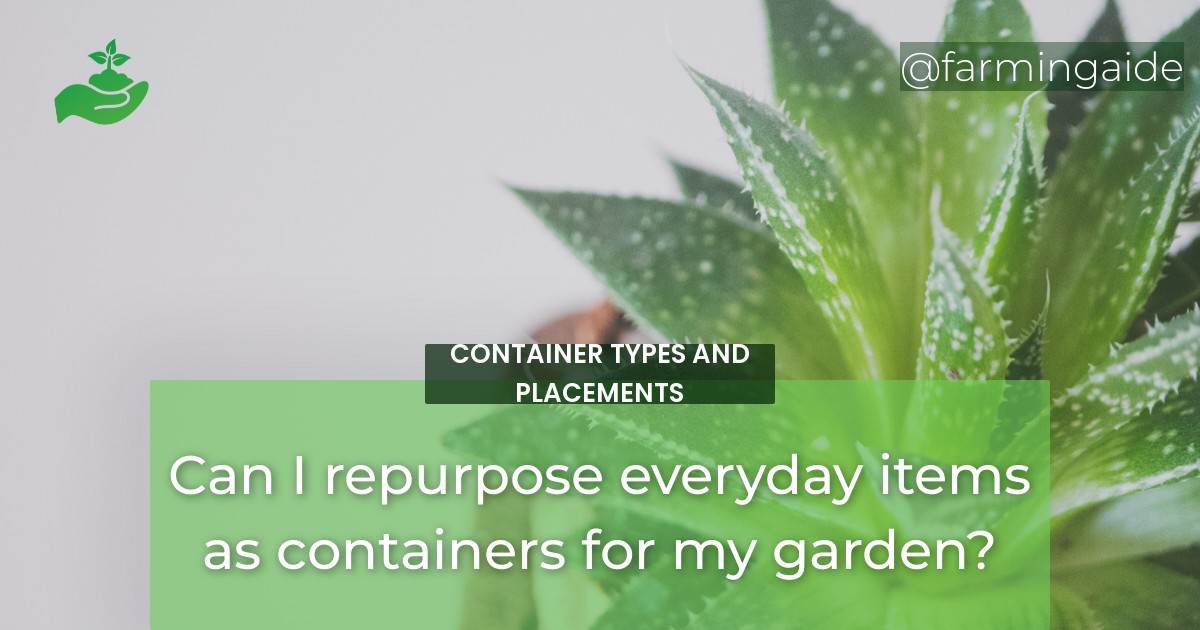Can you repurpose everyday items as containers for your garden? The answer is yes! Repurposing common household items as containers for gardening is an eco-friendly, cost-effective, and creative way to add more greenery to your home. By reusing items that are often discarded, you can reduce waste and create unique and personalized planters for your plants.
Table of Contents
Benefits of Repurposing Common Household Items as Containers for Gardening
Cost-Effective
Instead of purchasing expensive pots or planters, you can save money by using items that you already have at home. Repurposing old cans, jars, and bottles, for example, can be a great way to add a touch of greenery to your home without breaking the bank.
Environmentally-Friendly
Repurposing common household items for gardening is an eco-friendly way to reduce waste and give new life to items that might otherwise end up in a landfill. By reusing items like old furniture, pallets, and rain gutters, you can help reduce your carbon footprint and create a more sustainable home.
Unique and Creative
Using repurposed containers for your plants can add a unique and personal touch to your home and garden. By getting creative with the items you choose and the way you use them, you can create one-of-a-kind planters that reflect your style and personality.
Space-Saving
Repurposing items like shoes, boots, and kitchen containers can be a great way to add more greenery to your home without taking up too much space. By using items that can be hung or mounted on walls, you can create a vertical garden that is both space-saving and visually appealing.
Factors to Consider When Choosing Household Items as Containers for Gardening
Material
When choosing items to repurpose as planters, it is important to consider the material they are made of. Some materials, like metal or plastic, can get very hot in the sun and may not be the best choice for plants that are sensitive to heat. Other materials, like wood or terracotta, can absorb moisture and may be more prone to rot or fungal growth.
Size and Depth
The size and depth of your container will depend on the type of plant you want to grow. Some plants, like herbs or small flowers, can thrive in shallow containers, while others, like tomatoes or peppers, will need deeper containers to allow for root growth.
Drainage
Proper drainage is essential for the health of your plants. When repurposing items as planters, be sure to add drainage holes to allow excess water to escape. Without proper drainage, your plants may become waterlogged and susceptible to root rot or other fungal diseases.
Mobility
Consider how easy it will be to move your container once it is filled with soil and plants. Some items, like old furniture or rain gutters, may be heavy and difficult to move once they are planted. If you plan to move your plants around frequently, consider using lighter or more portable items like shoes or kitchen containers.
Creative Ideas for Repurposing Common Household Items as Containers for Gardening
Old Cans, Jars, and Bottles
- Clean and sanitize the containers
- Add drainage holes
- Fill with potting soil and plant herbs, flowers, or succulents
Tires
- Fill with potting soil and plant flowers or vegetables
- Paint the tires for a more decorative look
Shoes and Boots
- Fill with potting soil and plant small flowers or herbs
- Hang the shoes on a wall or fence
Pallets
- Stand the pallet up vertically
- Fill with potting soil and plant flowers or vegetables in the spaces between the slats
Kitchen Containers
- Use old teapots or kettles as planters for small herbs or flowers
- Repurpose plastic containers like yogurt cups or takeout containers as seed starters
Old Furniture
- Repurpose old dressers or cabinets as multi-level planters
- Use wooden chairs as plant stands
Rain Gutters and Pipes
- Hang rain gutters or pipes on a wall or fence
- Fill with potting soil and plant succulents or trailing plants
Tips for Repurposing Household Items as Containers for Gardening
Clean and Sanitize the Items
Before using any household items as planters, be sure to clean and sanitize them to remove any dirt, grime, or bacteria that may be present. This will help ensure that your plants stay healthy and disease-free.
Add Drainage Holes
As mentioned earlier, proper drainage is essential for the health of your plants. Be sure to add drainage holes to your repurposed containers to allow excess water to escape.
Choose Appropriate Plants
When choosing plants for your repurposed containers, consider their size, growth habits, and lighting needs. Some plants, like herbs or succulents, are well-suited for small containers and low-light conditions, while others, like tomatoes or peppers, will need larger containers and full sun.
Consider Placement and Sunlight
When choosing where to place your repurposed containers, consider the amount of sunlight that they will receive. Most plants need at least 6 hours of sunlight per day to grow and thrive. Placing your containers in a sunny spot will help ensure that your plants get the light they need.
Experiment with Different Ideas
Repurposing household items as containers for gardening is a fun and creative activity. Don’t be afraid to experiment with different ideas and materials to create unique and personalized planters for your home and garden.
Conclusion
Repurposing common household items for gardening containers is a fun, creative, and cost-effective way to add more greenery to your home. With a little imagination and some basic knowledge, you can turn almost anything into a container for your plants. Just remember to choose appropriate materials, add drainage holes, and choose plants that are well-suited for your container and lighting conditions.


